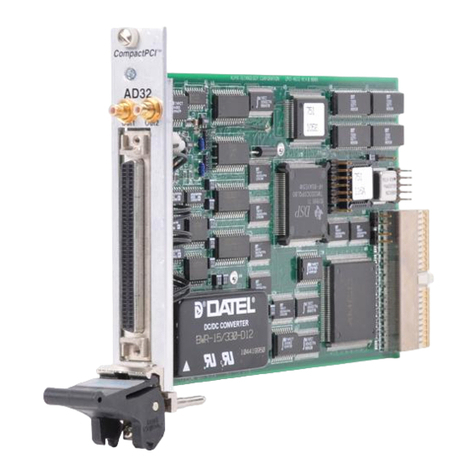
CPCI-QIPC REFERENCE MANUAL
ALPHI TECHNOLOGY CORP. Page 1Ver 1.1
Part Number : 739-11-000-4000 Copyright ALPHI Technology Corporation ,1998
1. GENERAL DESCRIPTION
1.1 INTRODUCTION
The CPCI-QIPC is a CPCI expansion card in a 6U form factor. The CPCI-QIPC provides
mechanical support and the electrical interfaces for four single width IP modules, or two
double width IP modules. Multiple CPCI-QIPC boards may be installed in a single system.
The primary features of the CPCI-QIPC are as follows:
•Support for up to four IP modules
•8 MHz or 32 MHz IP operation via jumper selection
•On board DSP C31 to offload I/O operation from host or standalone applications
•Direct memory mapped control of DSP from CPCI bus via AMCC 5933 PCI Chip
•Direct dual ported memory access from CPCI bus and C31 (up to 4 Mbytes)
•Full interrupt support of host and DSP C31
•Supports double-wide form factor IndustryPack
•Front panel I/O connectors for all IPs
1.2 FUNCTIONAL DESCRIPTION
A functional block diagram of the CPCI-QIPC is presented below in Figure 1-1. The jumper
placement is depicted in Figure 1-2 and the connector placement in Figure 1-3. The CPCI-
QIPC can operate as a slave that is managed by the host processor on the CPCI bus or it
can operate in a standalone mode of operation without a host. The IP modules share a
common clock that can be jumpered for 8 or 32 MHz operation. Each pair of single width
IPs, or each double width IP is individually selectable as to clock rate.
The CPCI-QIPC is supported by ALPHI Technology under Windows NT by a Board
Support Package which is supplied with the card. Other documentation supplied with the
card will describe this support in full detail.
The card is also supported by a DSP Support Library providing the following features:
•Common access routines for communications with the host
•Mapping C language standard input and output by the DSP to the onboard 8530 serial
chip
•Identify the applicable card resources and parameters
All these are provided in a manner consistent across ALPHI Technology platforms. Other
documentation supplied with the card will describe the support in full detail.
A bootloader provided on the card allows for control by the HOST and for independent
operation in stand alone operation. User code can be downloaded to FLASH memory and
booted automatically on reset. Access to the card can be made both by the HOST CPCI
bus and serially through the 8530.




























